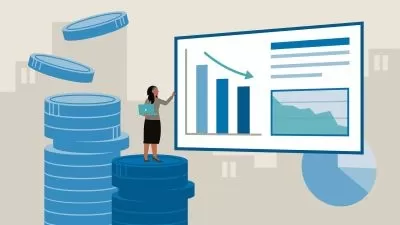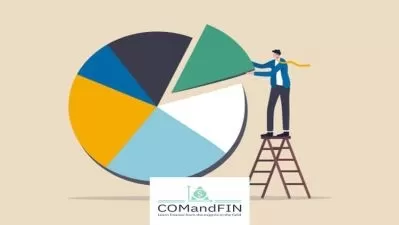Cost Accounting - A Comprehensive Study for CA/CMA/CS /ACCA/
Raja Natarajan, B.Com., PGDBA, FCA
37:57:29
Description
Learn basic to advanced concepts in Cost Accounting comprehensively
What You'll Learn?
- Understand Basics of Cost Accounting
- Understand Material Costing
- Understand Labour Costing
- Understand Overheads Costing
- Understand Standard Costing Techniques
- Understand Standard Costing Variances
- Understand Operating Costing
- Understand Marginal Costing
Who is this for?
What You Need to Know?
More details
DescriptionWho should take this course?
Are you struggling in understanding Costing concepts and techniques like Material Costing, Labour Costing, Overheads Costing, Standard Costing, Marginal Costing, Operating Costing, Contract Costing, Job Costing, Batch Costing, Process Costing, Joint Products & By-Products, Budget & Budgetary Control, Activity Based Costing?
Are you a student pursuing professional courses like CA / CMA / CS / CFA /CPA / ACCA / CIMA / MBA Finance or are you a Finance Professional / Banker aspiring to excel in Costing Techniques and rise to top in your career?
Then this course is for you - Cost Accounting A Comprehensive Study.
Why you should take this course?
By taking this course, you will be able to see practical side of Cost Accounting concepts with lot many case studies to solve. Approaching complex topics through case studies is the best way to understand them and you will find lot many in this course.
If you a Professional course student in the line of Finance or Accounting, then you would have Cost Accounting will be one of your major subject. This course will explain theory and practical concepts in Cost Accounting which will help you to excel in Academic Examinations.
If you are an Accounting or Finance or Cost Accounting Executive, this course will help you to brush up you basics in Cost Accounting and all the contents have immediate practical relevance and application.
What you will learn by taking this course?
This is a comprehensive course, covering each and every topic in detail. In this course,you will learn the Cost Accounting basic concepts, theories, and techniques which deals with conceptual frame work. You will be exposed to following concepts and Techniques: Â
Basics of Costing - 46+ Lectures
Material Costing - 47+ Lectures
Labour Costing - 24+ Lectures
Overheads Costing - 31+ Lectures
Standard Costing Techniques - 12+ Lectures
Standard Costing Variances - 16+ Lectures
Operating Costing - 5+ Lectures
Process Costing - 8+ Lectures
Budget and Budgetary Control - 17+ Lectures
Marginal Costing - 26+ Lectures
Contract Costing - 11+ Lectures
Joint Products &Â By Products - 14+ Lectures
Non Integrated Accounts - 19+ Lectures
Job Costing and Batch Costing - 19+ Lectures
ABC Costing -8+ Lectures
How this course is structured?
This course is structured in self paced learning style. Each and every section of this course is broken down as various micro lectures and then they are substantiated with examples and case studies. Several real world examples are used in this course through case studies. You'll gain authority on each and every topic as i take you through lectures one by one. This course is presented in simple language with examples. This course has video lectures (with writings on Black / Green Board / Note book / Talking head, etc). You would feel you are attending a real class. Â
What are the pre-requisites for taking this course?
You should have basic knowledge of Accounting. You would require good internet connection for interruption free learning process.
How this course will benefit you?
At the end of the course, you will be able to solve various case studies in Cost Accounting at ease with high level of confidence. This course will equip you for approaching above listed professional examinations with confidence as well hand real life problems with clarity.
Happy Learning and Best Wishes!
Who this course is for:
- Cost Accounting Students and Executives
- Accounting Students and Executives
- Finance Students and Executives
- MBA Finance Students
- B.Com., BBA, CA, CMA, CS, CFA, CPA, CIMA Students
Who should take this course?
Are you struggling in understanding Costing concepts and techniques like Material Costing, Labour Costing, Overheads Costing, Standard Costing, Marginal Costing, Operating Costing, Contract Costing, Job Costing, Batch Costing, Process Costing, Joint Products & By-Products, Budget & Budgetary Control, Activity Based Costing?
Are you a student pursuing professional courses like CA / CMA / CS / CFA /CPA / ACCA / CIMA / MBA Finance or are you a Finance Professional / Banker aspiring to excel in Costing Techniques and rise to top in your career?
Then this course is for you - Cost Accounting A Comprehensive Study.
Why you should take this course?
By taking this course, you will be able to see practical side of Cost Accounting concepts with lot many case studies to solve. Approaching complex topics through case studies is the best way to understand them and you will find lot many in this course.
If you a Professional course student in the line of Finance or Accounting, then you would have Cost Accounting will be one of your major subject. This course will explain theory and practical concepts in Cost Accounting which will help you to excel in Academic Examinations.
If you are an Accounting or Finance or Cost Accounting Executive, this course will help you to brush up you basics in Cost Accounting and all the contents have immediate practical relevance and application.
What you will learn by taking this course?
This is a comprehensive course, covering each and every topic in detail. In this course,you will learn the Cost Accounting basic concepts, theories, and techniques which deals with conceptual frame work. You will be exposed to following concepts and Techniques: Â
Basics of Costing - 46+ Lectures
Material Costing - 47+ Lectures
Labour Costing - 24+ Lectures
Overheads Costing - 31+ Lectures
Standard Costing Techniques - 12+ Lectures
Standard Costing Variances - 16+ Lectures
Operating Costing - 5+ Lectures
Process Costing - 8+ Lectures
Budget and Budgetary Control - 17+ Lectures
Marginal Costing - 26+ Lectures
Contract Costing - 11+ Lectures
Joint Products &Â By Products - 14+ Lectures
Non Integrated Accounts - 19+ Lectures
Job Costing and Batch Costing - 19+ Lectures
ABC Costing -8+ Lectures
How this course is structured?
This course is structured in self paced learning style. Each and every section of this course is broken down as various micro lectures and then they are substantiated with examples and case studies. Several real world examples are used in this course through case studies. You'll gain authority on each and every topic as i take you through lectures one by one. This course is presented in simple language with examples. This course has video lectures (with writings on Black / Green Board / Note book / Talking head, etc). You would feel you are attending a real class. Â
What are the pre-requisites for taking this course?
You should have basic knowledge of Accounting. You would require good internet connection for interruption free learning process.
How this course will benefit you?
At the end of the course, you will be able to solve various case studies in Cost Accounting at ease with high level of confidence. This course will equip you for approaching above listed professional examinations with confidence as well hand real life problems with clarity.
Happy Learning and Best Wishes!
Who this course is for:
- Cost Accounting Students and Executives
- Accounting Students and Executives
- Finance Students and Executives
- MBA Finance Students
- B.Com., BBA, CA, CMA, CS, CFA, CPA, CIMA Students
User Reviews
Rating
Raja Natarajan, B.Com., PGDBA, FCA
Instructor's Courses
Udemy
View courses Udemy- language english
- Training sessions 365
- duration 37:57:29
- English subtitles has
- Release Date 2024/03/22











